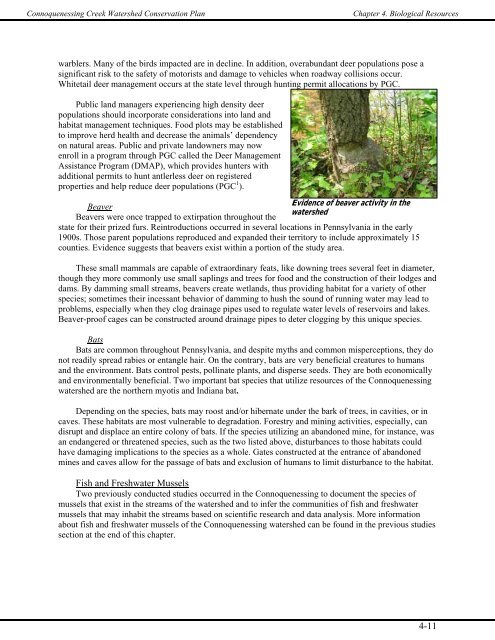CHAPTER 4 - Western Pennsylvania Conservancy
CHAPTER 4 - Western Pennsylvania Conservancy
CHAPTER 4 - Western Pennsylvania Conservancy
Create successful ePaper yourself
Turn your PDF publications into a flip-book with our unique Google optimized e-Paper software.
Connoquenessing Creek Watershed Conservation Plan<br />
Chapter 4. Biological Resources<br />
warblers. Many of the birds impacted are in decline. In addition, overabundant deer populations pose a<br />
significant risk to the safety of motorists and damage to vehicles when roadway collisions occur.<br />
Whitetail deer management occurs at the state level through hunting permit allocations by PGC.<br />
Public land managers experiencing high density deer<br />
populations should incorporate considerations into land and<br />
habitat management techniques. Food plots may be established<br />
to improve herd health and decrease the animals’ dependency<br />
on natural areas. Public and private landowners may now<br />
enroll in a program through PGC called the Deer Management<br />
Assistance Program (DMAP), which provides hunters with<br />
additional permits to hunt antlerless deer on registered<br />
properties and help reduce deer populations (PGC 1 ).<br />
Beaver<br />
Beavers were once trapped to extirpation throughout the<br />
Evidence of beaver activity in the<br />
watershed<br />
state for their prized furs. Reintroductions occurred in several locations in <strong>Pennsylvania</strong> in the early<br />
1900s. Those parent populations reproduced and expanded their territory to include approximately 15<br />
counties. Evidence suggests that beavers exist within a portion of the study area.<br />
These small mammals are capable of extraordinary feats, like downing trees several feet in diameter,<br />
though they more commonly use small saplings and trees for food and the construction of their lodges and<br />
dams. By damming small streams, beavers create wetlands, thus providing habitat for a variety of other<br />
species; sometimes their incessant behavior of damming to hush the sound of running water may lead to<br />
problems, especially when they clog drainage pipes used to regulate water levels of reservoirs and lakes.<br />
Beaver-proof cages can be constructed around drainage pipes to deter clogging by this unique species.<br />
Bats<br />
Bats are common throughout <strong>Pennsylvania</strong>, and despite myths and common misperceptions, they do<br />
not readily spread rabies or entangle hair. On the contrary, bats are very beneficial creatures to humans<br />
and the environment. Bats control pests, pollinate plants, and disperse seeds. They are both economically<br />
and environmentally beneficial. Two important bat species that utilize resources of the Connoquenessing<br />
watershed are the northern myotis and Indiana bat.<br />
Depending on the species, bats may roost and/or hibernate under the bark of trees, in cavities, or in<br />
caves. These habitats are most vulnerable to degradation. Forestry and mining activities, especially, can<br />
disrupt and displace an entire colony of bats. If the species utilizing an abandoned mine, for instance, was<br />
an endangered or threatened species, such as the two listed above, disturbances to those habitats could<br />
have damaging implications to the species as a whole. Gates constructed at the entrance of abandoned<br />
mines and caves allow for the passage of bats and exclusion of humans to limit disturbance to the habitat.<br />
Fish and Freshwater Mussels<br />
Two previously conducted studies occurred in the Connoquenessing to document the species of<br />
mussels that exist in the streams of the watershed and to infer the communities of fish and freshwater<br />
mussels that may inhabit the streams based on scientific research and data analysis. More information<br />
about fish and freshwater mussels of the Connoquenessing watershed can be found in the previous studies<br />
section at the end of this chapter.<br />
4-11














